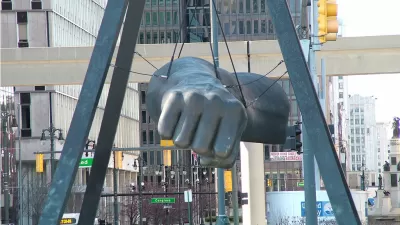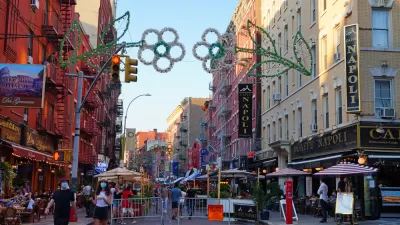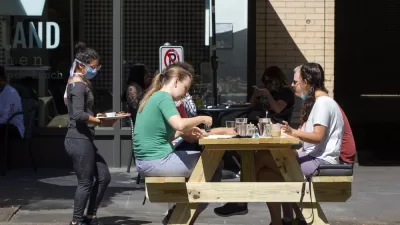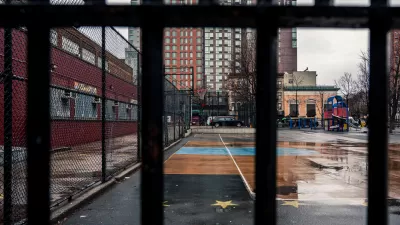A New York Times editorial presents a resoundingly pro-urban call to action regarding the future of planning and investment.

The Editorial Board of the New York Times published a feature-length defense of cities that also serves as a call to action for policy makers: break down class divides to rebuild urban areas in the wake of the coronavirus.
"The cities we need," the title of the editorial, builds its case on the history of cities as the "hammering engines of the nation’s economic progress, the showcases of its wealth and culture, the objects of global fascination, admiration and aspiration."
That was before, according to the editorial—long before the coronavirus upended life in the United States. For decades the infrastructure that built the economic prowess of U.S. cities has crumbled, and class divides have grown. The pandemic threatens to exacerbate the negative effects of these trends, according to the editorial.
The pandemic has prompted some affluent Americans to wonder whether cities are broken for them, too. It has suspended the charms of urban life while accentuating the risks, reviving an hoary American tradition of regarding cities with fear and loathing — as cesspools of disease, an image that all too easily aligns with prejudices about poverty and race and crime. Even New York’s governor, Andrew Cuomo, has described New York City’s density as responsible for its suffering.
Here enters the central claim of the editorial: the compulsion to flee the city and to abandon the urban cause is "dangerously misguided." The best hope for the nation, as expressed here, is to break down the inequalities of the city, and to "change the harsh reality that the neighborhoods into which Americans are born delimit their prospects in life…"
The editorial's recommendations for achieving those lofty goals will prove controversial in every kind of community, such as reducing segregation by reversing the planning policies that exclude affordable housing development in affluent neighborhoods and by equitable investments in urban public schools.
This reader can't recall an editorial of such scope and ambition, including interactive features and requiring long-read patience of the audience. Similarly, this reader cannot recall such strict adherence to pro-urban polemics, even when delivered at the expense of suburban communities. A passage that describes a suburban community outside of Cincinnati as a parasite promises to inspire numerous counter arguments:
Life in America resembles an airline passenger cabin: separate entrances, separate seating areas, separate bathrooms. The Village of Indian Hill, a wealthy suburb of Cincinnati, touts its rural atmosphere, its “firm administration of zoning ordinances” and its “proximity to the cultural life of a large city.” It is, in short, a parasite, taking what it values from Cincinnati while contributing as little to it as possible. In this, it is hardly unique. Hundreds of similar suburbs encrust cities across the United States.
For more on the future direction of urban planning and cities in the post-Covid future, see previous Planetizen coverage gathered under the "Coronavirus and Density" tag.
FULL STORY: The Cities We Need

Planetizen Federal Action Tracker
A weekly monitor of how Trump’s orders and actions are impacting planners and planning in America.

USGS Water Science Centers Targeted for Closure
If their work is suspended, states could lose a valuable resource for monitoring, understanding, and managing water resources.

Congress Moves to End Reconnecting Communities and Related Grants
The House Transportation and Infrastructure Committee moved to rescind funding for the Neighborhood Equity and Access program, which funds highway removals, freeway caps, transit projects, pedestrian infrastructure, and more.

Dairy Queen and Rural Third Places
Dozens of Dairy Queen restaurants across Texas are closing, taking a critical community space with them.

Pittsburgh Excels at Low-Cost, Quick-Build Traffic Calming
The city’s traffic calming initiative has led to a 6 percent average reduction in speeds on corridors with recent interventions.

Seattle Transit Asked to Clarify Pet Policy
A major dog park near a new light rail stop is prompting calls to update and clarify rules for bringing pets on Seattle-area transit systems.
Urban Design for Planners 1: Software Tools
This six-course series explores essential urban design concepts using open source software and equips planners with the tools they need to participate fully in the urban design process.
Planning for Universal Design
Learn the tools for implementing Universal Design in planning regulations.
City of Moorpark
City of Tustin
Tyler Technologies
City of Astoria
Transportation Research & Education Center (TREC) at Portland State University
Chaddick Institute at DePaul University
Regional Transportation Commission of Southern Nevada
Toledo-Lucas County Plan Commissions





























